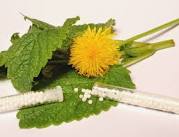HOMEOPATHIC REMEDIES FOR COLD & FLU
 I am often asked how to determine whether one’s symptoms are related to cold or flu. The truth is, in the case of homeopathic prescribing, the label of what you have is less important than the compilation of the symptoms. Most importantly, how you are experiencing your symptoms is vital information to the prescribing homeopath. In the case of homeopathy, it is often quite possible for two people, each with a cold, to need two different remedies for their symptoms. For example, two individuals may both report having a headache – one person may describe the headache as throbbing; the other may feel like he has a metal band around his head. The nature of how each of these individuals experiences his pain leads the homeopath to a remedy specific to his experience.
I am often asked how to determine whether one’s symptoms are related to cold or flu. The truth is, in the case of homeopathic prescribing, the label of what you have is less important than the compilation of the symptoms. Most importantly, how you are experiencing your symptoms is vital information to the prescribing homeopath. In the case of homeopathy, it is often quite possible for two people, each with a cold, to need two different remedies for their symptoms. For example, two individuals may both report having a headache – one person may describe the headache as throbbing; the other may feel like he has a metal band around his head. The nature of how each of these individuals experiences his pain leads the homeopath to a remedy specific to his experience.
Another consideration when discussing homeopathy, is to understand the correct definition of homeopathy. Homeopathy is not herbalism, is not a blanket term for alternative or complimentary medicine, is not acupuncture, hands-on healing, or nutrition. Homeopathy is a system of medicine based upon the concept of “like cures like.” Homeopathy uses medicines that are derived from plant, mineral or animal sources and are regulated by the FDA. Homeopathy remedies are carefully prepared in manufacturing pharmacies according to strict production standards.
In today’s blog, I’ve included a list of the most commonly used remedies for the compilation of symptoms that we lovingly refer to as “cold” or “flu”.
These remedies are often supportive for colds:
Allium cepa: This remedy is made from the onion and is best used for symptoms that include watery, burning mucous. Discharge may irritate the nostrils or upper lip. There is often fluent tearing from the eyes, accompanied by sneezing. Symptoms are worse in warm or stuffy rooms. One may feel slightly spacey.
Arsenicum: This remedy is well-suited for burning or irritating watery nasal discharge that may be worse on the right side. One often complains of feeling chilly and is aggravated from being exposed to cold. Typically one has great thirst but drinks only sips at a time.
Belladonna: Sudden onset of a cold that is accompanied by a high fever (over 102 degrees), flushed cheeks, and a reddened sore throat is the core of this remedy picture. One often has glassy eyes, dilated pupils, hot hands and feet, and a cool abdomen. _
Kali bichromicum: This remedy may do well for one who had a cold that has evolved into sinusitis. Thick, stringy, yellow-green nasal discharge and postnasal drip is often seen in one who needs this remedy.
Nux vomica: One may need this remedy if symptoms of a cold started after overeating, over-working, over-drinking (alcohol), or other such abuses or excesses. One often experiences a runny nose during the day and in warm rooms, and a stuffy nose at night and indoors. One needing this remedy is often irritable and impatient, tending to obsess about work, even though feeling ill.
Pulsatilla: Those who are weepy, clingy, and wanting sympathy may need this remedy. Mucous tends to be thick, and yellow or greenish in color. There tends to be an aggravation of symptoms in warm, stuffy rooms and at night. These people prefer to breathe fresh, cool air and are often not very thirsty.
These remedies are best to use for the flu:
Arsenicum album: This remedy is suited for one who has “the stomach flu”and experiences nausea, vomiting, and fever. One may be very sensitive to and feel worse when exposed to cold. There is often great thirst, but only for sips of water at a time. One may feel restless and worry if they might be sicker than they actually are.
Bryonia: “Dry = Bry” is the catchy phrase for this remedy. One has dry, often chapped lips, a dry cough, and tremendous thirst for cold water. This is a flu with serious body aches that are aggravated by any type of motion. One may have a headache in the front part of the head that is aggravated by motion. One may be very irritable and insist upon being left alone.
Eupatorium perfoliatum: If needing this remedy, one may experience muscle aches, pains in the bones , and even pain in their eyes. Chills may occur in the morning. These people desire cold drinks, even during a chill and even though it may elicit a chill response, and they feel better lying on whatever part of their body is aching.
Gelsemium: Fatigue and weakness pervades one needing this remedy. Fever and chills are experienced up and down the spine. There is often a headache in the back part of the head. Typically little or no thirst is expressed.
Rhus toxicodendron: This remedy is effective when muscle aches are aggravated by initial motion but relieved by continued motion. One may be restless and have a sore throat. This is the remedy to consider should a cold sore develop during the flu.
While it is possible to successfully utilize homeopathic remedies at home, bear in mind that Certified Classical Homeopaths (CCH) undergo significant and specific training in this healing art. It is always wisest to consult with a professional homeopath who has been certified by the Council on Homeopathic Education.
AUTHOR
Jennette Cable, ND, CTN, CCH, ST, RSHom(NA) is a Doctor of Naturopathy, Classical Homeopath, and Sound Therapist. She is the founder and director of Creative Care & Wellness Center, a holistic wellness facility centered around The Five Tenets of Wellness™.



